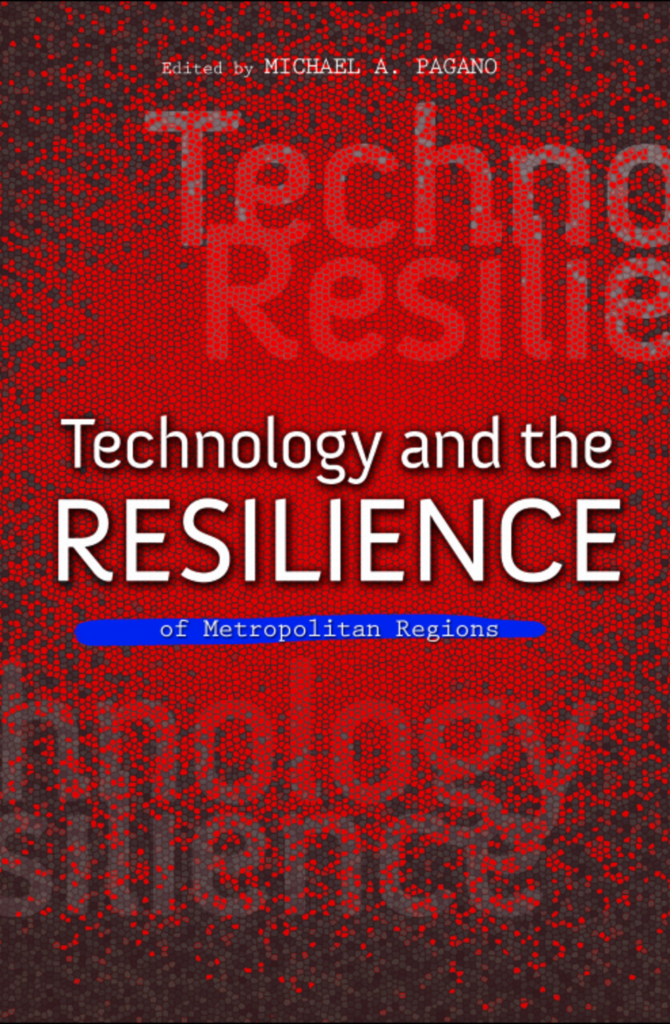 Today marks the publication of “Technology and the Resilience of Metropolitan Regions; Digital technologies and the future of cities”. Here’s the book blurb:
Today marks the publication of “Technology and the Resilience of Metropolitan Regions; Digital technologies and the future of cities”. Here’s the book blurb:
Can today’s city govern well if its citizens lack modern technology? How important is access to computers for lowering unemployment? What infrastructure does a city have to build in order to attract new business? Michael A. Pagano curates engagement with such questions by public intellectuals, academics, policy analysts, and citizens. Each essay explores the impact and opportunities technology provides in government and citizenship, health care, workforce development, service delivery to citizens, and metropolitan growth. As the authors show, rapidly emerging technologies and access to such technologies shape the ways people and institutions interact in the public sphere and private marketplace. The direction of metropolitan growth and development, in turn, depends on access to appropriate technology scaled and informed by the individual, household, and community needs of the region.
I wrote a chapter for this book titled, “Toward a Market Approach for Civic Innovation”. Here’s an extended excerpt:
In my work at the Smart Chicago Collaborative, I helped create the Open311 system for the municipal government of the City of Chicago. This has led to the publication of millions of rows of public data and simple methods for developers and nascent companies to read and write directly to the enterprise service request system at the City—the technology backbone for the delivery of services in the third largest city in the United States. This is the largest implementation of Open311 anywhere.
The existence of Open311 in Chicago, however, has not led to the creation of many new tools. Only a handful of services connect to this system, and none have any traction in the public. Even though it was widely requested by the developer community and touted as a major opportunity for economic growth, there are no widely used resident-focused websites or systems that use Open311.
The current state of the market
The question is why, and I believe the answer is that there is no cohesive market for the civic innovation sector of the technology industry. In fact, very few of the actors in the market even understand themselves to be a part of the technology industry. A dominant frame of the civic hacker movement is the quick creation of tools, dashed off in hackathons or over feverish nights. The idea of being a part of the trillion-dollar industry is anathema to this frame.
The natural end result of these efforts are interesting tools with good intentions that are of limited use to the masses in cities. The current status of the civic innovation sector of the technology industry can analyzed as follows:
- There is good movement in the provision of data (raw materials)
- There is an abundance of energy around the making of things (labor)
- There is a paucity of thought around the why we make things or what the best thing is to make (market research, user testing, continuous improvement)
- There is even less thought around the relationship between the things we make and the universe of other things within which it fits (market analysis)
- Lastly, all of our things exist in an environment where their popularity is puny next to the opportunity (market penetration)
This state of affairs was evident in Professor Fountain’s paper, which had a review of a wide range of existing projects, tools, and companies. Included were municipal-driven projects like Citizens Connect, Commonwealth Connect, and the work in San Francisco as well as companies like SeeClickFix, CitySourced, and Granicus. She covered nonprofit projects like FixMyStreet and Electorate.Me.
This was a great scan that covered the field well, but it is illustrative of the jumble that defines the current state of the civic innovation sector of the technology industry—it completely lacks a frame for understanding. And without a frame, it is difficult to grow.
Here’s the complete chapter: Technology and the Resilience of Metropolitan Regions – DXO Chapter
Purchase here at the publisher website or on Amazon.